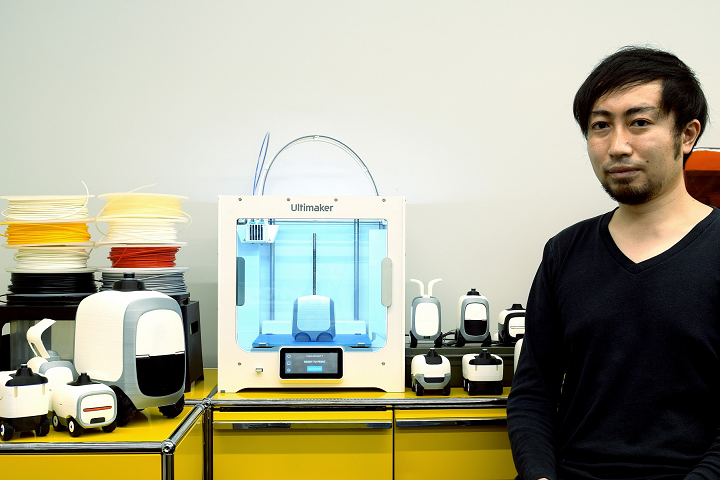There are plenty of examples of drones, 3D printed and otherwise, delivering items like food, medical supplies, and 3D printed spare parts, but what about ground delivery robots? We have seen 3D printed robots that can move through water and earth and complete tasks for us, such as mowing the lawn, performing small construction site jobs, and delivering medication. Now, Japanese design and technology firm Final Aim, Inc. is partnering with robotics startup OTSAW Digital PTE LTD to use 3D printing to solve issues with inefficient deliveries in Singapore’s logistics chain. Together, they used the Ultimaker S3 printer, courtesy of Ultimaker’s official Japanese sales partner Brulé, to create a last mile autonomous delivery robot, called Camello.
Yasuhide “Yasu” Yokoi is the co-founder of Final Aim, which uses Ultimaker 3D printers to ensure quick design iterations during prototyping for its customers. One of these projects is the autonomous package delivery robot Camello, which looks a bit like a smaller version of the autonomous 3D printed Olli shuttle. Because of long waiting periods in both loading and unloading bays, as well as low loads, tight deadlines, and high delivery volume, package deliveries in Singapore can be inefficient, which drives shipment costs up and causes operational issues as well. That’s why Final Aim and OTSAW decided to work together to shake things up in the package delivery sector.
“It has been truly magical to witness the teamwork between Final Aim Inc, OTSAW and our partner Brulé to bring this robot to life. This solution contributes to an improved logistic ecosystem for smooth and efficient delivery to customers, while increasing profit margins for those businesses that use it,” said William Lee, Channel Director at Ultimaker. “I am proud that our Ultimaker S3 contributed to the realization of this ambitious project.”
After developing the concept for the robot using design sketches and CAD software, Yokoi began presenting the idea to end-users, higher-level management, and frontline members, asking for feedback that would help him further expand on the idea. Then it was time for prototyping, which is where the Ultimaker 3 and Ultimaker Cura came in to play, and, as Yokoi noted in an Ultimaker blog post, the technology “added value” to the process, beyond just cutting costs.
“3D printing enabled us to bring our numerous ideas to life. The Ultimaker S3 is very easy to handle which gave me extra time to work on new designs while printing. Compared to other common prototyping methods, we found 3D printing to be much more efficient for prototyping,” Yokoi stated in a press release.
3D printing was also helpful to this project because the final design would feature organically curved surfaces, and the technology can analyze the curvature of surfaces using contour layers of printouts.
“The Ultimaker S3’s double extrusion feature has [also] been essential to my everyday design applications. Together with Breakaway and PVA material, my printing experience has become exponentially more efficient. I am deeply satisfied with the resulting quality as it leaves behind no support structure remaining,” Yokoi said.
The Camello delivery robot needed to have an accessible, intuitive design so that stakeholders, while handling the physical 3D printed prototypes, could fully understand the design and concept. The technology also helped speed up development as well, streamlining the decision-making process for the final design, which does not appear to be fully 3D printed.
As you can see, the user-friendly Camello robot has a sleek design, with an ergonomic cargo space that makes it a great fit for the urban environment of Singapore. Final Aim and OTSAW have been collaborating with larger industrial businesses, like DHL and NTUC FairPrice, which has resulted in the robot actually being used for grocery and parcel deliveries. But the pair are also working on plans for the Camello to be used by other delivery companies and retailers, so that the package delivery ecosystem in Singapore can become more efficient, and increase profit margins for the businesses that use the last mile autonomous delivery robot.
(Source/Images: Ultimaker)
Subscribe to Our Email Newsletter
Stay up-to-date on all the latest news from the 3D printing industry and receive information and offers from third party vendors.
Print Services
Upload your 3D Models and get them printed quickly and efficiently.
You May Also Like
3D Printing News Briefs, July 2, 2025: Copper Alloys, Defense Manufacturing, & More
We’re starting off with metals in today’s 3D Printing News Briefs, as Farsoon has unveiled a large-scale AM solution for copper alloys, and Meltio used its wire-laser metal solution to...
3DPOD 260: John Hart on VulcanForms, MIT, Desktop Metal and More
John Hart is a Professor at MIT; he´s also the director of the Laboratory for Manufacturing and Productivity as well as the director of the Center for Advanced Production Technologies....
3D Printing News Briefs, June 28, 2025: Defense Accelerator, Surgical Models, & More
In this weekend’s 3D Printing News Briefs, 3YOURMIND was selected to join an EU Defense Accelerator, and PTC has announced model-based definition (MBD) capabilities within Onshape. Finally, a study out...
EOS in India: AM’s Rising Star
EOS is doubling down on India. With a growing base of aerospace startups, new government policies, and a massive engineering workforce, India is quickly becoming one of the most important...




































